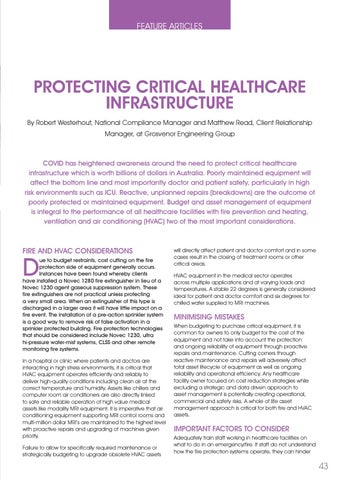FEATURE ARTICLES
PROTECTING CRITICAL HEALTHCARE INFRASTRUCTURE By Robert Westerhout, National Compliance Manager and Matthew Read, Client Relationship Manager, at Grosvenor Engineering Group
COVID has heightened awareness around the need to protect critical healthcare infrastructure which is worth billions of dollars in Australia. Poorly maintained equipment will affect the bottom line and most importantly doctor and patient safety, particularly in high risk environments such as ICU. Reactive, unplanned repairs (breakdowns) are the outcome of poorly protected or maintained equipment. Budget and asset management of equipment is integral to the performance of all healthcare facilities with fire prevention and heating, ventilation and air conditioning (HVAC) two of the most important considerations.
FIRE AND HVAC CONSIDERATIONS
D
ue to budget restraints, cost cutting on the fire protection side of equipment generally occurs. Instances have been found whereby clients have installed a Novec 1280 fire extinguisher in lieu of a Novec 1230 agent gaseous suppression system. These fire extinguishers are not practical unless protecting a very small area. When an extinguisher of this type is discharged in a larger area it will have little impact on a fire event. The installation of a pre-action sprinkler system is a good way to remove risk of false activation in a sprinkler protected building. Fire protection technologies that should be considered include Novec 1230, ultra hi-pressure water-mist systems, CLSS and other remote monitoring fire systems. In a hospital or clinic where patients and doctors are interacting in high stress environments, it is critical that HVAC equipment operates efficiently and reliably to deliver high-quality conditions including clean air at the correct temperature and humidity. Assets like chillers and computer room air conditioners are also directly linked to safe and reliable operation of high value medical assets like modality MRI equipment. It is imperative that air conditioning equipment supporting MRI control rooms and multi-million dollar MRI’s are maintained to the highest level with proactive repairs and upgrading of machines given priority. Failure to allow for specifically required maintenance or strategically budgeting to upgrade obsolete HVAC assets
will directly affect patient and doctor comfort and in some cases result in the closing of treatment rooms or other critical areas. HVAC equipment in the medical sector operates across multiple applications and at varying loads and temperatures. A stable 22 degrees is generally considered ideal for patient and doctor comfort and six degrees for chilled water supplied to MRI machines.
MINIMISING MISTAKES When budgeting to purchase critical equipment, it is common for owners to only budget for the cost of the equipment and not take into account the protection and ongoing reliability of equipment through proactive repairs and maintenance. Cutting corners through reactive maintenance and repairs will adversely affect total asset lifecycle of equipment as well as ongoing reliability and operational efficiency. Any healthcare facility owner focused on cost reduction strategies while excluding a strategic and data driven approach to asset management is potentially creating operational, commercial and safety risks. A whole of life asset management approach is critical for both fire and HVAC assets.
IMPORTANT FACTORS TO CONSIDER Adequately train staff working in healthcare facilities on what to do in an emergency/fire. If staff do not understand how the fire protection systems operate, they can hinder
43

















